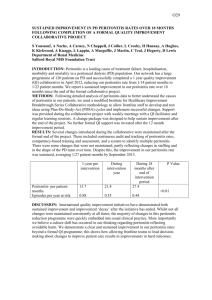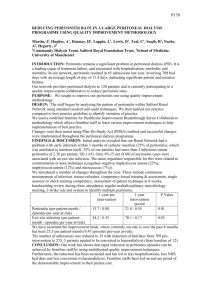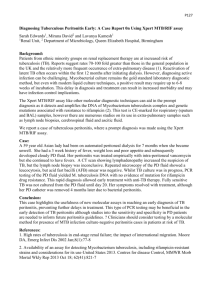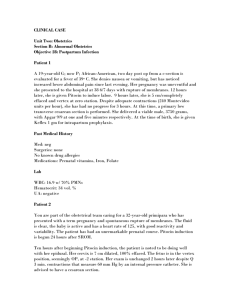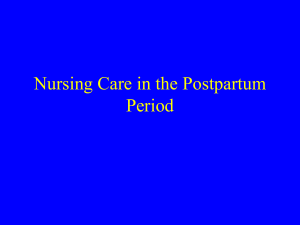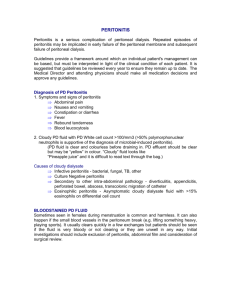Pathology postpartum. Secondary postpartum hemorrhage
advertisement
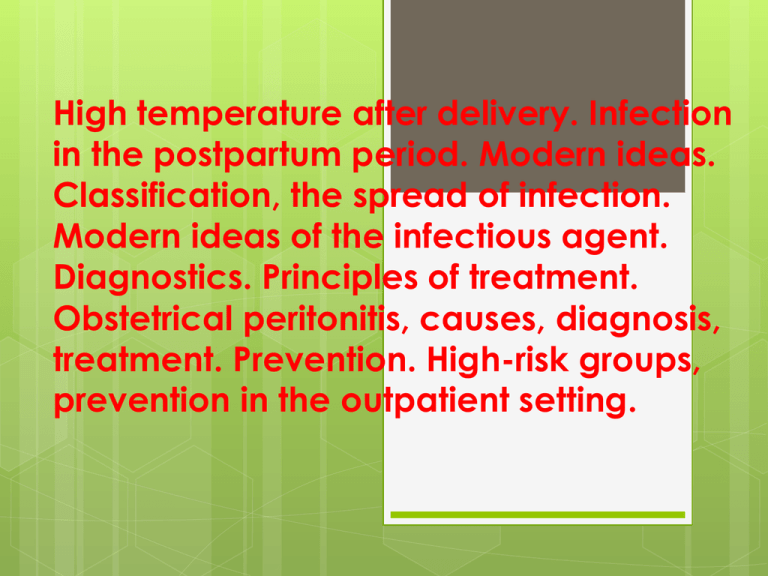
High temperature after delivery. Infection in the postpartum period. Modern ideas. Classification, the spread of infection. Modern ideas of the infectious agent. Diagnostics. Principles of treatment. Obstetrical peritonitis, causes, diagnosis, treatment. Prevention. High-risk groups, prevention in the outpatient setting. The agents of pre-and postnatal infections may be microorganisms. Many of them are normal flora of the female genital tract. Postpartum infection pathogens may also be pathogens, sexually transmitted diseases (gonorrhea and chlamydia). Postpartum endometritis Postpartum endometritis usually been mild and ends in recovery, but every 4th parturients he has a severe course, while there is purulent resorptive fever and, in addition, there is a real threat to the generalization of infection. Mild form of the disease is characterized by relatively late onset (5-12th day postpartum), raising the temperature to 38-38 degrees C, the absence of fever, a mild increase in erythrocyte sedimentation rate (30-55 mm / h), leukocytosis in the range 9.12 . 10 9 per liter, a slight alteration of the formula neutrophil white blood cells. The general health of patients does not change, sleep and appetite remain good, no headaches. Somewhat enlarged uterus, lochia long are blood. The total protein content of blood, residual nitrogen remains unchanged. In order to establish the severity of the patient's condition must be continuous monitoring of respiration, hemodynamics, urine output, the dynamics of laboratory data on the background of complex treatment within 24 h of light frme disease condition of the patient per day did not significantly deteriorate. In severe rapid improvement for the day, as a rule, is not even possible negative dynamics of the process. Severe endometriosis starts at 2 to 3 days after birth, every 4th patient, he develops in the presence of chorioamnionitis. Usually determined by uterine tenderness, purulent lochia become, with ichorous smell. Severe endometriosis is usually combined with other purulent-septic diseases. In recent years, more and more clinical picture does not reflect the severity of the woman in childbirth. The time of appearance of symptoms ranged from 1 to 7-days after the birth. Moreover, clinical data and laboratory test results indicates a mild current. Under this option, quickly comes generalization of infection, as applied treatments (mostly formally appointed) did not have the desired effect. Reduced immune reactivity in pregnant women is a favorable background for the development of septic complications in childbirth and the postpartum period. On the other hand, the focus of inflammation are known to serve as reservoir of germs and toxins, but also a source of sensitization. Importantly, to the presence of abortive forms of endometritis is not served as a basis for the "gentle" treatment. Endometritis after cesarean always be severe. Sick suffer from headaches, fatigue, sleep disturbances, appetite, pain in the lower abdomen. Characteristic tachycardia (heart rate over 110 beats / min) temperature exceeds 39oS. In 3 of 4 patients with fever is an additional increase in body temperature. The number of leukocytes ranges from 14 to 30. 10 ^ / l in all patients the neutrophil white blood shift formula. Anemia develops in every third patient. Endometritis after cesarean always occurs with signs of intoxication and intestinal paresis. Most often, they have been reported in patients who underwent surgery during the excessive bleeding, loss of fluid and electrolytes. In patients after surgery are determined signs of hypovolemia, hypoproteinemia and hypokalemia. The clinical picture is characterized by weakness, headache, dry mouth, flatulence, decreased urine output. Determined marked leukocytosis, neutrophilic shift formula of white blood leukocytes toxic granularity. Against the background of prophylactic antibiotics, infusion-transfusion therapy and other methods of influence clinical endometritis after cesarean delivery is changing. Reduced symptoms of inflammation (not determined marked leukocytosis, no shift leukocyte counts, no hectic rise in temperature, chills). No clear signs of local inflammation, is not determined by uterine tenderness, increasing its size by bimanual examination. Specific component of Intensive Care Endometritis. The first step is to focus on the impact of the site of infection - the uterus. This requires an accurate and early diagnosis, one of the options, it is an ultrasound. It allows you to set the degree of involution of the uterus, the presence of residues of the ovum in its cavity, the walls of the uterus. In identifying the contents of the uterus (about 70% of women in childbirth) is preferable to produce a vacuum aspiration, which is a safer intervention than curettage curette. Aspiration should be performed under the general anesthesia in combination with components of intensive care unit (atibakterialnaya, infusiontransfusion, detoxification, etc.). Possible and curettage subject to certain safeguards. In the absence of a significant amount of content in a limited expansion of the uterus cervix under anesthesia) to create a robust outflow to reduce absorption of the products of decay and toxins shown uterine lavage solutions of antiseptics and antibiotics. Our experience shows that it is better to apply the solution was cooled and the duration of the perfusion solution at a temperature of 12 degrees C without autonomic defense against hypothermia should not exceed 30 minutes. With prolonged washing of the uterine cavity must use double-barreled catheter. Perfusion pressure should not exceed 20 cm of water column, the usual solution temperature - +12 - 15 degrees C. Active effect on the uterus with endometritis can significantly reduce toxicity, prevent the generalization of infection, keep NATK. However, in advanced endometrial (in puerperal state, which is regarded as moderate to very severe), you must also conduct a set of common components of the intensive care unit. Common components INTENSIVE CARE ENDOMET Rita. Antibiotic therapy. In our daily work using the principle of early administration of antibiotics broad spectrum. To prescribe antibiotics at the same time a combination of at least two antibiotics in the highest dose level taking into account the sensitivity of the microflora, released from the blood and wounds, sometimes in combination with Dioksidin, solution furatsillina, metronidazole. In a combination of antibiotics include ceftriaxone 1.0 2 times a day, 400mg Abaktal / in 5-10% glucose solution, tsefamezin by 3.0 grams a day, efloran 100ml / drip. Almost all NSAIDs inhibit the formation of prostaglandins, acting synergistically on other mediators of inflammation, which reduces the effect of bradykinin, histamine, serotonin and other The special features of obstetric tactics with endometritis were the following: 1. Once the diagnosis or vakuumaspiratsiyu scraping the uterus should be done only on the background of general anesthesia and continuing intensive therapy. 2. Effectively describe the complex intensive therapy should be evaluated no later than one day of treatment. With a decrease in uterine volume, stabilization clinical and laboratory parameters and improving the health of patients should consider the impact on the primary site is sufficient. In case of failure of the treatment, even against the background of the satisfactory condition of patients, but the remaining clinical and laboratory signs of inflammation should raise the issue of hysterectomy - than later, removal of the uterus, the worse the prognosis and the greater the risk of sepsis and infectious-toxic shock. Postpartum ulcer (chronic inflammatory process in the perineum, vulva, vagina, cervix). Unlike postpartum endometritis in postpartum ulcer likelihood of generalization process is much smaller, but it is not excluded. Patients with postpartum ulcers are a source of infection for healthy childbirth. In the presence of an inflammatory infiltrate in the joints and perineum wound should be open and allow free flow of wound. With festering necessary drainage of purulent cavities and thorough washing of antiseptic liquids. Impregnated with purulent and necrotic tissue should be excised past. To stimulate the formation of granulation tissue, it calls for full proteolytic enzymes (trypsin and chymotrypsin) and providing hyperbaric oxygenation. For this 1020 mg diluted in 25-50 silt 0.25% solution of novocaine. Gauze pads soaked with a solution injected into the wound. Proteolytic enzymes in the third to reduce the healing time of postpartum ulcer and allow earlier deferred to impose the secondary seams. Antibiotic and fluid therapy for postpartum ulcer shown with symptoms of intoxication and fever. The principles of the treatment is the same as in the treatment of postpartum endometritis. INFECTION of the wound after cesarean section. Clinical presentation during infection of the wound is characterized by both local and general symptoms. The patient has weakness, loss of appetite, pain in the wound, the body temperature is taken to 38-38, 5 degrees C are defined infiltration of the wound the skin redness and soreness. Increased white blood cell count, increased S0E. Every 7th patient has not expressed enteroplegia may be single vomiting, intestinal peristalsis is preserved. When suppuration of the wound tissue is removed and stitches provide outflow of wound, pus cavity should be drained. In auditing the wounds to exclude eventration, as it is a sign of peritonitis, and calls for the production of hysterectomy with uterine tubes. In the treatment of the wound festering known principles guided surgery (Kuzin MK Kostichenok BM, 1981): excision of tissue, providing drainage, the suppression of inflammation and swelling, flushing and physical active antiseptic). Shows antibiotic treatment, restorative, infusion therapy, the appointment of proteolytic enzymes. Treatment is carried out on the same principles. OBSTETRIC Peritonitis Obstetrical peritonitis - one of the most serious complications in slerodovogo period. The source of infection is the most uterus (horiamnionit in childbirth, postpartum endometritis, uterine dehiscence after cesarean section). The important role of the uterus as a portal of entry is determined by the presence in it of blood clots and the remnants of the ovum, is an excellent medium for the growth of microorganisms. In addition, the pregnant uterus has a large surface area for bacterial and tissue resorption of toxins, and promote blood circulation particularly its massive flow of bacterial flora and toxins in the bloodstream. Infection with peritonitis develops in the sensitization during pregnancy and changes her hormonal homeostasis (primarily iatrogenic), and secondary immunodeficiency. Obstetrical peritonitis often has slack, worn over, especially after C-section, in which there is no damage to the integrity of the bowel or other organs of the gastrointestinal tract The leading role in the genesis of pathophysiological reactions in peritonitis belongs intoxication caused by bacterial toxins, tissue proteases, biogenic amines (histamine, serotonin, kinin) and hypovolemia ("no return" fluid loss from krovyanosnogo riverbed deposits and sequestration of blood in the vessels of the abdominal and part of the chest cavity), paralysis (paresis) of the gastrointestinal tract. The nature and severity of changes in peritonitis defined different combination of factors such as the type, virulence, number of infiltrators into the abdominal cavity of microbes, the prevalence of the duration of the pathological process, the immune system of the body In most cases with peritonitis show a mixed microbial flora, however, has a leading role, E. coli, and Staphylococcus aureus, Pseudomonas aeruginosa and Proteus vulgaris. Proteinaceous toxins (polypeptides, tissue proteases, bacteria and their waste products), toxins - crystalloids (ammonia), biogenic amines (histamine, serotonin, heparin), soaked in blood, cause profound changes in the body. The source of infection of the abdominal cavity after caesarean section may also be due to increased permeability of the intestinal wall paresis for toxins and bacteria "This phenomenon was established almost 100 years ago and repeatedly confirmed by subsequent research" However microbial invasion into the abdominal cavity is accompanied by the development of the typical pattern of peritonitis with massive exudation, severe functional disturbances and metobolicheskimi only under certain conditions. The third and most common version of peritonitis caused by infection of the abdominal cavity due to lack of seams in the womb. The clinical picture of peritonitis midwifery consists of a series of general and local symptoms. When obstetric peritonitis local manifestations are less pronounced and the reactive phase quickly moves into a phase of intoxication. Thus, in the "early" form of obstetrical peritonitis, signs of intoxication, psychomotor agitation, thirst, dry mucous membranes, tachycardia, weakness. The severity of the patient is determined by a combination of virulence of the infection and the rate of development of multiple organ failure, in particular, the degree of hypovolemia due to prolonged labor, excessive blood loss during surgery, a large loss of electrolytes and fluids. The clinical picture of the second form of midwifery at the onset of peritonitis dominates enteroplegia, symptoms of postpartum endometritis sidelined. The severity of the patient is determined by the growing phenomena of intoxication. which occurs as a result of violation of the barrier function of the intestine. and due to resorption of toxic products from the uterus. According to the third form of peritonitis due to lack of seams on the uterus and receipt of the infectious agent into the peritoneal cavity in the clinical picture more clearly reflected local symptoms. On the background of marked enteroparesis determined positive symptom SHCHetkina-Blumberg, "muscular defense", vomiting, loose stools and frequent with a pungent odor, clear local tenderness on palpation. However, given the complex intensive care clinical peritonitis may obscured and Recognition is only possible when a "return" of symptoms. During the operation, the surgeon must clarify the nature of the form of peritonitis exudate (serous, fibrinous or purulent), and the prevalence of abdominal lesions (limited, diffuse or full). In most cases, after 4 days from the time of the cesarean observed purulent exudate, the defeat of the peritoneum is most often diffuse. Clarification forms of peritonitis necessary to address the application of the "abdominal dialysis" indication for the meeting is the total peritonitis or disease, with intoxication. Along with the local therapy of peritonitis after cesarean (removal of the uterus, abdominal drainage, stomach, and some patients bowel or ileostomy) is necessary and general medicine. The purpose of general medicinecompensation pathophysiological disturbances and fighting infection and intoxication. Considering the provisions defining the general therapy, one must pay attention to the sequence of therapeutic measures, In peritonitis after cesarean section when there is no destruction of any portion of the gastrointestinal tract, surgical treatment is carried out on urgent indications. However, it is not limited to a few hours, as the surgical peritonitis, caused destructive appendicitis, perforated gastric ulcer, intestinal, etc. Consequently, the total therapy should precede surgical treatment performed or simultaneously with it. Peritonitis caused by the anaerobic flora, it is appropriate we used a hyperbaric oxygen possessing, powerful hypoxic, antipareticheskim and detoxifying effects. Thus, the tactics of the patient depends on the form of peritonitis, the severity of her condition and hemodynamic disturbances occurred, fluid and electrolyte, protein metabolism, disorders of microcirculation, tissue metabolism, damage to internal organs. Integrated intensive therapy solves all questions correct disability. Properly conducted therapy peritonitis can in some cases (the "early" peritonitis) avoid traumatic and disabling operations (hysterectomy), and mortal danger that it possible to represent a peritonitis. Thus obstetrical peritonitis - is a dangerous complication of cesarean delivery, abortion is rarely (if the perforation of the uterus), late diagnosis and inadequate treatment of which is fatal. Characteristic of the flow is the virulence of this disease infection, polymicrobial landscape, bacterial resistance to many antibiotics, reducing the body's defenses. Effacement of symptoms, poor flow, undulating course amid intensive care cause delay in diagnosis and surgery, leading to maternal mortality. To prevention are healthy women of reproductive age, readjustment of foci outside and during pregnancy, strict accounting contraindications cesarean population, adherence to the operating mode sanepid generic unit, increased attentive management of patients exposed to / from the intensive care and rehabilitation units. Thus purulent-septic diseases after birth represent ugpozy mother's life. In order to prevent them should be treated with foci of chronic infection in women before pregnancy: dental caries, chronic tonsillitis, purulent sinusitis, pyelonephritis, colpitis, cervicitis, cervical erosion, enterocolitis. During pregnancy should also conduct health and sanitation of medical therapies foci of latent infection, increase the protective properties of the female organism. Thank you for attention
